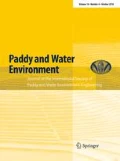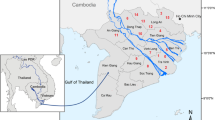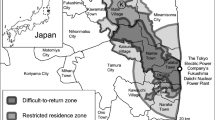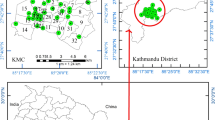Abstract
Radiocesium released from Fukushima Daiichi nuclear power plant in March 2011 was accumulated in paddy fields within 5 cm of the surface soil layer. In order to remove this radiocesium, Japanese government carried out decontamination work to strip off surface layer soil. For this reason, the paddy fields of Iitate Village of Fukushima Prefecture are filled with a lot of flexible container bags packed with contaminated soil. On the other hand, based on the nature that radiocesium is fixed to clay minerals, we conducted an in situ burial experiment of contaminated soil at a paddy field in Iitate Village, Fukushima Prefecture, and have been testing rice cultivation every year at the paddy field where soil contaminated with radiocesium was buried. However, there remains fear that radiocesium might be released again to the environment. In order to prove that radiocesium will not leak from the paddy field, we are measuring the soil radiation doses in the well from March 2015. As a result of measurement of soil radiation doses every half year, we found that the soil radiation doses have a Gaussian distribution with a peak of which depth has not changed for 3 years. This indicates that radiocesium is unlikely to leach further through the contaminated soil even under conventional rice production in a paddy field.




Similar content being viewed by others
References
MAFF, Ministry of Agriculture, Forestry and Fisheries (2013) Technical document on measures against decontamination of agricultural land. February 2013. http://www.maff.go.jp/j/nousin/seko/josen/. Accessed 6 Jan 2019 (in Japanese)
Mizoguchi M (2011) Challenges in remediation of agricultural soil contaminated by radioactive substances—agricultural engineering for earthquake disaster reconstruction. In: Proceedings of the PAWEES 2011 international conference, National Taiwan University, Taiwan, pp 22–31. http://www.iai.ga.a.u-tokyo.ac.jp/mizo/edrp/fukushima/mizoguchi(PAWEES2011).pdf. Accessed 6 Jan 2019
Mizoguchi M (2019) Challenges of agricultural land remediation and renewal of agriculture in Iitate village by a collaboration between researchers and a non-profit organization. In: Nakanishi TM, Tanoi K (eds) Agricultural implications of the Fukushima nuclear accident (III). Springer, Tokyo, pp 177–190
Mizoguchi M, Ito T, Tao Y (2013) Burial experiment of soil contaminated by radiocesium at a paddy field in Iitate Village, Fukushima Prefecture. Abstracts of Water, Land and Environmental Engineering meeting (in Japanese)
Mizoguchi M, Tao Y, Kanno M (2015a) Radiation measurement in paddy soil layer that was buried contaminated topsoil in Fukushima. In: SSSA international annual meeting, Minneapolis, USA. http://www.iai.ga.a.u-tokyo.ac.jp/mizo/edrp/fukushima/poster/ASA151116-2.pdf. Accessed 6 Jan 2019
Mizoguchi M, Itakura Y, Kanno M, Tao Y (2015b) Radiation measurement in paddy soil layer that was buried contaminated topsoil. Abstracts of Abstracts of Water, Land and Environmental Engineering meeting (in Japanese)
Nemoto K, Abe J (2013) Radiocesium absorption by rice in paddy field ecosystems. In: Nakanishi TM, Tanoi K (eds) Agricultural implications of Fukushima nuclear accident. Springer, Tokyo, pp 19–26
Nishimura T (2017) Fast and slow migration of Cs in soils—how do we understand? J Jpn Soc Soil Phys 135:25–31 (in Japanese with English summary)
Resurrection of Fukushima (2019) http://www.fukushima-saisei.jp. Accessed 6 Jan 2019
Shiozawa S, Tanoi K, Nemoto K, Yoshida S, Nishida K, Hashimoto K, Sakurai K, Nakanishi TM, Nihei N, Ono Y (2011) Vertical concentration profiles of radioactive cesium and convective velocity in soil in a paddy field in Fukushima. Radioisotopes 60:323–328
Yamaguchi N, Takata Y, Hayashi K, Ishikawa S, Kuramata M, Eguchi S, Yoshikawa S, Sakaguchi A, Asada K, Wagai R, Makino T, Akahane I, Hiradate S (2012) Behavior of radiocaesium in soil–plant systems and its controlling factor: a review. Bull Natl Inst Agro-Environ Sci 31:75–129 (in Japanese with English summary)
Yokokawa H, Mizoguchi M (2013) Collaboration structure aimed at resurrection of Iitate Village. J Jpn Soc Soil Phys 125:53–54 (in Japanese with English summary)
Acknowledgements
I would like to thank the non-profit organization (NPO) “Resurrection of Fukushima” members (President: Mr. Yoichi Tao) who worked together with us, and the local farmers (Mr. Muneo Kanno, Mr. Kinichi Okubo, Mr. Takeshi Yamada, and Mr. Keiichi Kanno) who provided us with land in Iitate Village for the past 7 years to carry out our field experiments.
Author information
Authors and Affiliations
Corresponding author
Rights and permissions
About this article
Cite this article
Mizoguchi, M. Monitoring of soil radiation doses from contaminated soil buried in a paddy field in Iitate Village, Fukushima. Paddy Water Environ 17, 299–302 (2019). https://doi.org/10.1007/s10333-019-00723-4
Received:
Revised:
Accepted:
Published:
Issue Date:
DOI: https://doi.org/10.1007/s10333-019-00723-4




